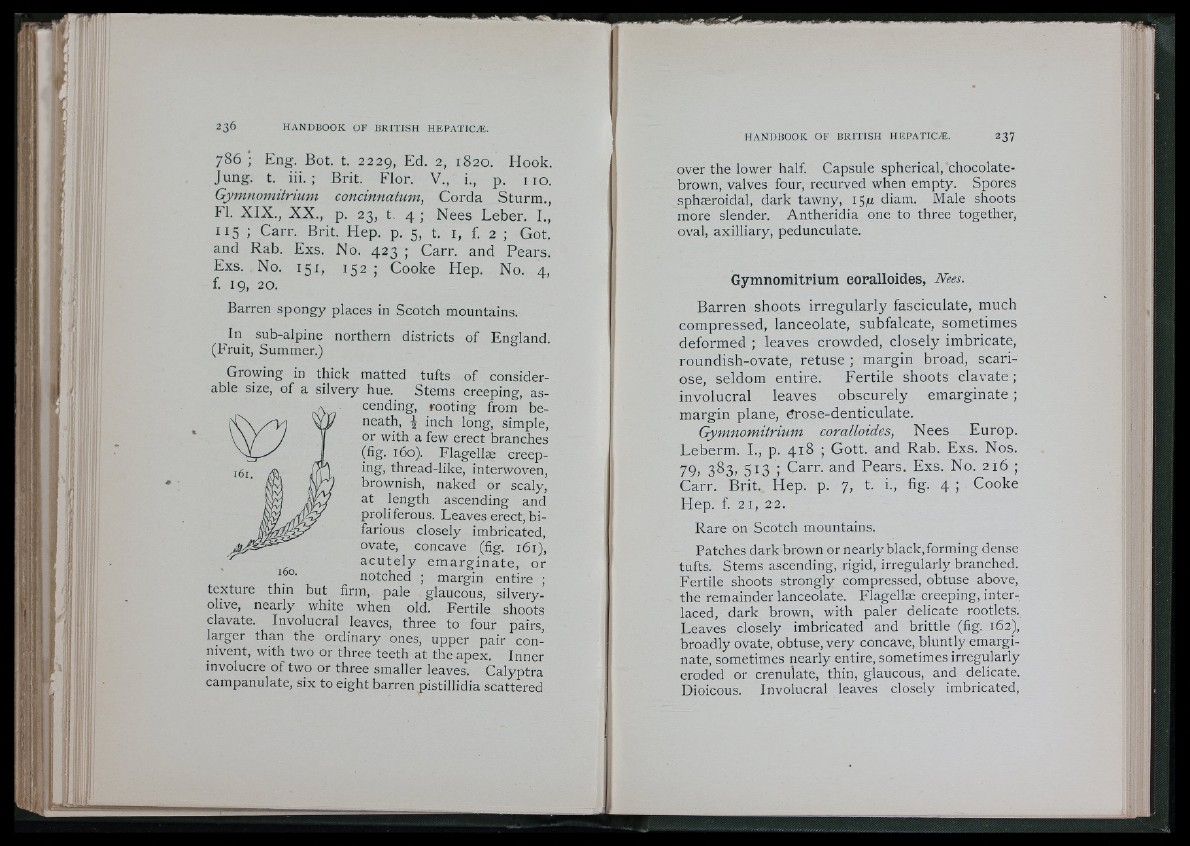
; ' l í J
786 ; Eng. Bot. t. 2229, Ed. 2, 1820. Hook.
Jung. t. i ii . ; Brit. Flor. V., i., p. n o .
Gymnomitrium eoneinnatum, Corda Sturm.,
i l . X IX . , X X . , p. 23, t. 4 ; Nees Leber . I.,
1 1 5 ; Carr. Brit. Hep. p. 5, t. i, f. 2 ; Got.
and Rab. Exs. No. 423 ; Carr, and Pears.
Exs. No. 151 , 152 ; Co o ke Hep. No. 4,
f. 19, 20.
Barren spongy places in Scotch mountains.
In sub-alpine northern districts of England.
(Fruit, Summer.)
Growing in thick matted tufts of considerable
size, of a silvery hue. Stems creeping, ascending,
rooting from beneath,
i inch long, simple,
or with a few erect branches
(fig. 160). Flagellae creeping,
thread-like, interwoven,
brownish, naked or scaly,
at length ascending and
proliferous. Leaves erect, bifarious
closely imbricated,
ovate, concave (fig. 161),
a c u t e l y em a r g in a t e , or
notched ; margin entire ;
160.
texture thin but firm, pale glaucous, silvery-
olive, nearly white when old. Fertile shoots
clavate. Involucral leaves, three to four pairs,
larger than the ordinary ones, upper pair con-’
invent, with two or three teeth at the apex. Inner
involucre of two or three smaller leaves. Calyptra
campanulate, six to eight barren pistillidia scattered
over the lower half. Capsule spherical, chocolate-
brown, valves four, recurved when empty. Spores
sphaeroidal, dark tawny, 15/x diam. Male shoots
more slender. Antheridia one to three together,
o\al, axilliary, pedunculate.
Gymnomitrium eoralloides, Nees.
Bar ren shoots ir regula r ly fasciculate, much
compressed, lanceolate, subfalcate, somet imes
deformed ; leaves crowded, c losely imbricate,
roundish-ovate, retuse ; margin broad, scari-
ose, seldom entire. Fer t ile shoots clavate ;
involucral leaves obs curely emarginate ;
margin plane, drose-denticulate.
Gymnomitrium eoralloides, Ne e s Europ.
Leberm. I., p. 4 18 ; Got t . and Rab. Exs. Nos.
7 9 ) 383, 513 ; Carr, and Pears. Exs. No. 216 ;
Carr. Brit. Hep. p. 7, t. i., fig. 4 ; Cooke
Hep. f. 21, 22.
Rare on Scotch mountains.
Patches dark brown or nearly black, forming dense
tufts. Stems ascending, rigid, irregularly branched.
Fertile shoots strongly compressed, obtuse above,
the remainder lanceolate. Flagellae creeping, interlaced,
dark brown, with paler delicate rootlets.
Leaves closely imbricated and brittle (fig. 162),
broadly ovate, obtuse, very concave, bluntly emarginate,
sometimes nearly entire, sometimes irregularly
eroded or crenulate, thin, glaucous, and delicate.
Dioicous. Involucral leaves closely imbricated.